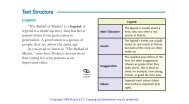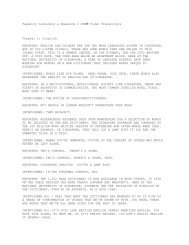Symbols - Heinle
Symbols - Heinle
Symbols - Heinle
You also want an ePaper? Increase the reach of your titles
YUMPU automatically turns print PDFs into web optimized ePapers that Google loves.
Exercise 1<br />
Circle the topic and underline the controlling idea in each of these topic<br />
sentences.<br />
1. The colors we wear change our emotions.<br />
2. People who wear orange like to communicate with others.<br />
3. People who wear red clothes want to have fun.<br />
4. Shoes give us lots of information about the person wearing them.<br />
5. Patterns on clothing give us clues to the mood of the wearer.<br />
6. People who wear yellow are often creative.<br />
7. Turquoise is good for people who have decisions to make.<br />
8. People who wear green often like the outdoors.<br />
Supporting Sentences<br />
Supporting sentences develop the topic sentence. They give the reader<br />
reasons, examples, and more facts about the topic sentence. They must<br />
all be related to the topic sentence.<br />
Exercise 2<br />
Look at the underlined topic sentences. In each case, one of the<br />
sentences below it does not support the topic sentence. Circle the letter<br />
of your answer.<br />
1. Colors are often divided into two groups, warm and cold.<br />
a. The warm colors are red, pink, yellow, and orange.<br />
b. These colors are associated with activity and energy.<br />
c. Violet is the color of royalty and is often worn by political and<br />
religious leaders.<br />
d. The cold colors—blue, purple, violet, and brown—are calm and<br />
mysterious.<br />
10 Unit 1 ■ <strong>Symbols</strong>







